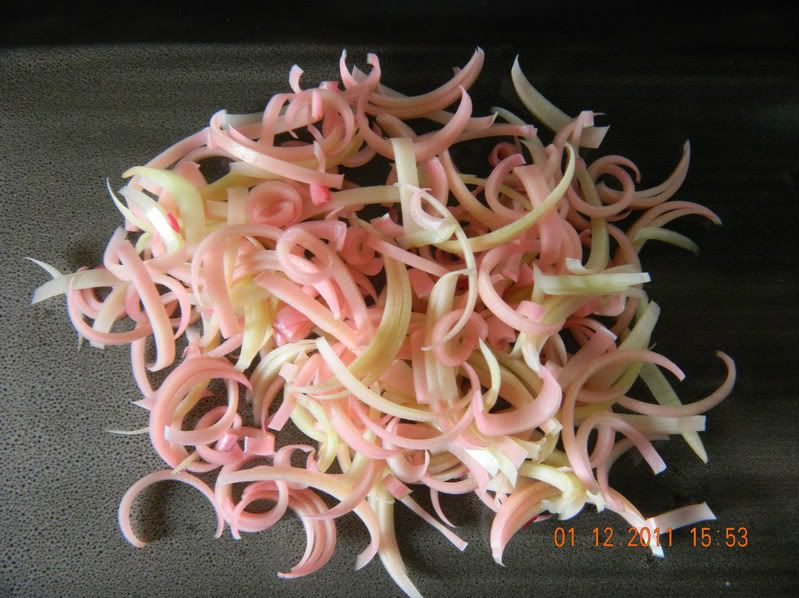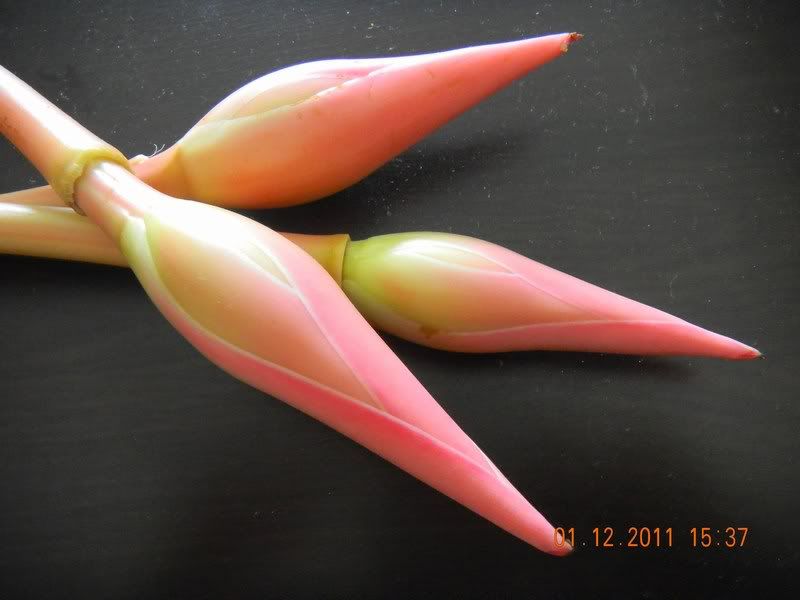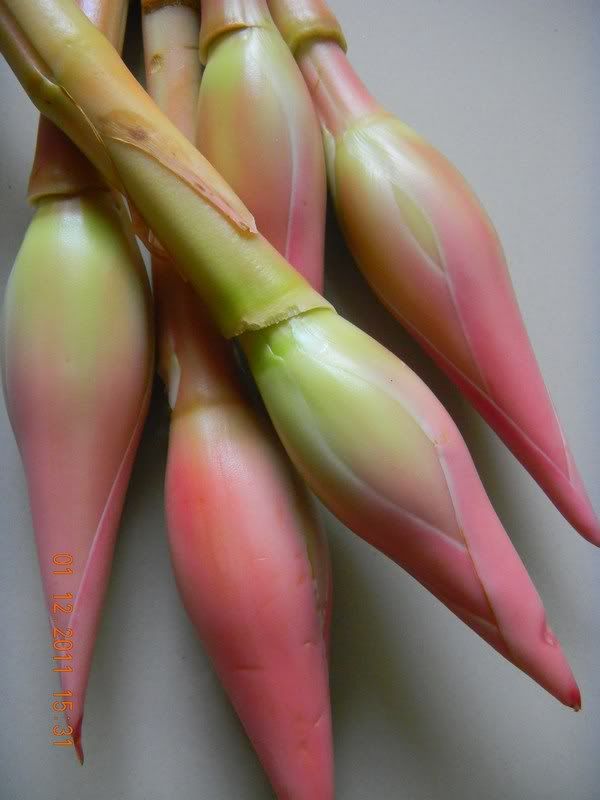My first encounter with ginger
flowers occurred when I was just a little kid. I can't recall the
exact time or place. I just knew that that particular dish of rojak I
was eating tasted different, in a really wonderful though inexplicable
way. I didn't then, nor now, have the vocabulary to describe this new taste
sensation, except to note that I had never tasted rojak like this before.
Most Singaporeans encounter ginger flowers when they eat rojak. Even then, not all rojak sellers include this ingredient, so there may be some poor souls who are deprived of this exquisite taste. Other than rojak, ginger flowers are used only in certain recipes found in Nonya and Malay cuisines - like Penang Laksa and Nasi Ulam.
How does one describe the taste of ginger flowers? Tasted on its own, the petals give off only slight flowery accents that end on a somewhat sour note. But when included in a recipe, they transform into a lilting floral and gentle perfume - not cloying the way an overdose of rose flavour can be. Other than that, it is a flavour that is difficult to grasp in a tangible way. To me the taste of ginger flowers is ethereal, up-lifting and simply magical.

Since ginger flowers are an uncharacteristic ingredient in the repertoire of daily meals, they are hence not commonly found in supermarkets. You have a better chance of finding them in wet markets where they are usually sold by one of the vegetables stalls. Tekka market is the one place where ginger flowers are seen in abundance. By that I mean that about 3 or 4 of the vegetable stalls offer this item - a whole bunch of the flower buds in their unmistakable shade of pink with light green slender stalks. When you come across these flower buds, buy a few as they freeze very well. They can be frozen whole if you plan to use an entire bud in a recipe. Or detach the petals and divide them among several bags for easier access if only a small amount is required at a time.
I am doing a series of Asian herbs recipes, with particular interest in using some of these herbs in desserts. Curiously this gentle flower bud seems to dominate the recipes I am attempting to create, so much so that I have decided to do a category of recipes featuring it as the star. The ginger flower lends itself well to both sweet and savoury cooking. I have used ginger flowers in making crumble and muffins for the book The Asian Oven.
Yesterday, I made ginger flower-kaffir lime-coconut ice cream. The texture was disappointing - the ice cream turned out more like a sorbet. However the floral and coconutty flavours were distinct yet not overwhelming, and complement each other charmingly. But the lime was not detected at all. Some serious tweaking is in order.
You will read of the outcome once I taste success!
For many years, I have resisted the bidding of friends and family to start a blog. Finally, out of sheer perversity, I have done it. If nothing else, it is also to demystify the process of creating one. Maintaining a blog would be a work in progress for me - there are too many things to learn at one go.
Alright, now to posting proper.
In his book, The Nasty Bits, Anthony Bourdain described chicken rice, one of Singapore's iconic dishes, as:
"...basically, boiled chicken and white rice."
My jaw dropped in horror and utter incomprehension at those words. Would you describe a hamburger as cooked meat and bread? Or our beloved rojak as pieces of vegetables in a brown sauce?
Before you decide to hurl a bunch of chicken bones at his head, Mr Bourdain did offer more descriptive details a couple of paragraphs later, after he had sampled the dish at Tian Tian Hainanese Chicken Rice:
"...a heap of soft, pillowy white rice with pale, juicy chunks of chicken piled in the
center. A little cucumber, some supersticky spicy hoisin-style sauce, a little
grated ginger, and a garlic pepper sauce are served on the side. You mix it all
together to fit personal preferences....I watched locals eagerly drizzling, dipping,
and mixing the basic elements into personalized concoctions..."
Mr Bourdain nailed the "personalized concoction" part. I like chicken rice au naturel. My sons prefer a generous drizzle of the thick dark sauce while my husband will mix in a healthy amount of grated ginger sauce.
I would extend "personal preferences" to include not just the sauces, but also a particular cut of the chicken. Most chicken rice connoisseurs prefer the thigh, drumstick or wing. And then there is the choice of white or roast chicken.
"A little cucumber"? He got that down pat too.
Now let's come to the rice. Calling this essential component of the dish "white rice" is wrong on so many levels. If Mr Bourdain had looked at his plate of chicken rice, he would have noticed that the rice is not white but an off-white or ivory colour, each grain coated with a thin layer of oil. White rice is what you get when rice grains are cooked in plain water. That ivory tint of chicken rice is a result of cooking rice grains in chicken broth with the inclusion of salt, ginger, garlic, pandan leaves, chicken fat (or vegetable oil) and sometimes, lemongrass. Some hawkers may even fry these ingredients in the chicken fat or oil before adding to the broth and rice. Cooked thus, the rice is infused with all the aromatic flavours, so good you can eat it on its own.
What about "boiled" chicken? Boiled chicken would taste only marginally juicier compared to jerky. Those "juicy chunks" of chicken are possible only when the chicken is not boiled. The white chicken that accompanies chicken rice is not steamed either. Instead a whole chicken is submerged in water that is brought to the boil only to have the heat turned off. The chicken is then left to slowly cook in the residual heat for about half an hour. The entire process is repeated 2 or 3 times, depending on the size of the chicken. This gentle method of cooking that veers towards poaching rather than boiling, ensures that the chicken is just cooked and retains most of its juices.
When Mr Bourdain next comes visiting, his local food guide, Mr Seetoh of Makansutra should serve him a dish of boiled chicken and white rice side by side with the real McCoy. Surely Mr Bourdain would then be able to discern the difference even as he customizes the dish to suit his preference?


